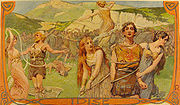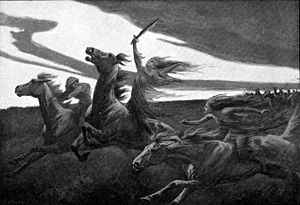
Idis (Germanic)
Encyclopedia

Germanic mythology
Germanic mythology is a comprehensive term for myths associated with historical Germanic paganism, including Norse mythology, Anglo-Saxon mythology, Continental Germanic mythology, and other versions of the mythologies of the Germanic peoples...
, an idis (Old Saxon
Old Saxon
Old Saxon, also known as Old Low German, is the earliest recorded form of Low German, documented from the 8th century until the 12th century, when it evolved into Middle Low German. It was spoken on the north-west coast of Germany and in the Netherlands by Saxon peoples...
, plural idisi) is a divine female being. Idis is cognate to Old High German
Old High German
The term Old High German refers to the earliest stage of the German language and it conventionally covers the period from around 500 to 1050. Coherent written texts do not appear until the second half of the 8th century, and some treat the period before 750 as 'prehistoric' and date the start of...
itis and Old English ides, meaning 'well-respected and dignified woman.' Connections have been assumed or theorized between the idisi and the North Germanic dís
Dis
- Academic institutions :* DIS – Danish Institute for Study Abroad, an English language study abroad program located in Copenhagen, Denmark* Dili International School, DIS an International School in Dili, Timor Leste - Companies :...
ir; female beings associated with fate, as well as the amended place name Idistaviso
Idistaviso
Idistaviso is the location on the Weser river where forces commanded by Arminius fought those commanded by Germanicus at the Battle of the Weser River in 16 CE, attested in chapter 16 of Tacitus' Annales II...
.
One of the two Old High German
Old High German
The term Old High German refers to the earliest stage of the German language and it conventionally covers the period from around 500 to 1050. Coherent written texts do not appear until the second half of the 8th century, and some treat the period before 750 as 'prehistoric' and date the start of...
Merseburg Incantations
Merseburg Incantations
The Merseburg Incantations are two medieval magic spells, charms or incantations, written in Old High German. They are the only known examples of Germanic pagan belief preserved in this language...
call upon female beings—idisi—to bind and hamper an army. The incantation reads:
- 'Once the Idisi sat, sat here and there,
- some bound fetters, some hampered the army,
- some untied fetters:
- Escape from the fetters, flee from the enemies.'
In line 1259 of the Old English poem Beowulf
Beowulf
Beowulf , but modern scholars agree in naming it after the hero whose life is its subject." of an Old English heroic epic poem consisting of 3182 alliterative long lines, set in Scandinavia, commonly cited as one of the most important works of Anglo-Saxon literature.It survives in a single...
, Grendel's Mother
Grendel's mother
Grendel's mother is one of three antagonists in the work of Old English literature of anonymous authorship, Beowulf . She is never given a name in the text....
is introduced as an ides:
- 1258: ... Grendles modor
- 1259: ides, aglæcwif ...
Interpretation
The idisi mentioned in the first Merseburg Incantation are generally considered to be valkyries. Rudolf Simek says that "these Idisi are obviously a kind of valkyrie, as these also have the power to hamper enemies in Norse mythology" and points to a connection with the valkyrie name HerfjöturHerfjötur
In Norse mythology, Herfjötur is a valkyrie. Herfjötur is attested as among the 13 valkyries listed in the Poetic Edda poem Grímnismál, and in the longer of the two Nafnaþulur lists found in the Prose Edda.Rudolf Simek says the name is kenning-like and that the name likely refers to the "fortune...
(Old Norse "army-fetter"). Hilda Ellis Davidson compares the incantation to the Old English Wið færstice
Wið færstice
Wið færstice is an Old English medical text composed in, surviving in the collection known now as Lacnunga. Wið færstice means 'against a sudden/violent stabbing pain'; scholars have often sought to identify this as rheumatism, but other possibilities should not be excluded. The remedy describes...
charm, and theorizes a similar role for them both.
Simek says that the West Germanic term Idisi (Old Saxon idis, Old High German itis, Anglo-Saxon ides) refers to a "dignified, well respected woman (married or unmarried), possibly a term for any woman, and therefore glosses exactly Latin matrona" and that a link to the North Germanic term dísir is reasonable to assume, yet that it is not undisputed. In addition, the place name Idisiaviso
Idistaviso
Idistaviso is the location on the Weser river where forces commanded by Arminius fought those commanded by Germanicus at the Battle of the Weser River in 16 CE, attested in chapter 16 of Tacitus' Annales II...
(meaning "plain of the Idisi") where forces commanded by Arminius
Arminius
Arminius , also known as Armin or Hermann was a chieftain of the Germanic Cherusci who defeated a Roman army in the Battle of the Teutoburg Forest...
fought those commanded by Germanicus
Germanicus
Germanicus Julius Caesar , commonly known as Germanicus, was a member of the Julio-Claudian dynasty and a prominent general of the early Roman Empire. He was born in Rome, Italia, and was named either Nero Claudius Drusus after his father or Tiberius Claudius Nero after his uncle...
at the Battle of the Weser River
Battle of the Weser River
The Battle of the Weser River, sometimes known as a first Battle of Minden, was fought in 16 AD between Roman legions commanded by Emperor Tiberius' heir and adopted son Germanicus, and an alliance of Germanic tribes commanded by Arminius...
in 16 CE. Simek points to a connection between name Idisiaviso, the role of the Idisi in one of the two Merseburg Incantations, and valkyries.

Guðrúnarkviða
Guðrúnarkviða I, II and III are three different heroic poems in the Poetic Edda with the same protagonist, Gudrun.In Guðrúnarkviða I, Gudrun finds her dead husband Sigurd...
I 19 the valkyries are even called Herjans disir 'Odin's disir'. The disir are explicitly called dead women in Atlamál
Atlamál
Atlamál in grœnlenzku is one of the heroic poems of the Poetic Edda. It relates the same basic story as Atlakviða at greater length and in a different style...
28 and a secondary belief that the disir were the souls of dead women (see fylgjur
Fylgja
In Norse mythology, a fylgja is a supernatural being or creature which accompanies a person in connection to their fate or fortune...
) also underlies the landdísir
Landdísir
In Norse mythology and later Icelandic folklore, landdísir are beings who live in landdísasteinar, specific stones located in Northwestern Iceland which were treated with reverence into the 18th and 19th centuries...
of Icelandic folklore
Scandinavian folklore
Scandinavian folklore is the folklore of Sweden, Norway, Denmark, Iceland, the Faroe Islands, and the Swedish speaking parts of Finland.Collecting folklore began when Gustavus Adolphus of Sweden sent out instructions to all of the priests in all of the parishes to collect the folklore of their area...
." Simek says that "as the function of the matrons was also extremely varied – fertility goddess, personal guardians, but also warrior-goddesses – the belief in the dísir, like the belief in the valkyries, norns, and matrons, may be considered to be different manifestations of a belief in a number of female (half-?) goddesses."
Jacob Grimm
Jacob Grimm
Jacob Ludwig Carl Grimm was a German philologist, jurist and mythologist. He is best known as the discoverer of Grimm's Law, the author of the monumental Deutsches Wörterbuch, the author of Deutsche Mythologie and, more popularly, as one of the Brothers Grimm, as the editor of Grimm's Fairy...
proposes a potential connection to the name of the Norse goddess Iðunn
Iðunn
In Norse mythology, Iðunn is a goddess associated with apples and youth. Iðunn is attested in the Poetic Edda, compiled in the 13th century from earlier traditional sources, and the Prose Edda, written in the 13th century by Snorri Sturluson...
and the idisi. Grimm states that "with the original form idis the goddess Idunn may possibly be connected."

